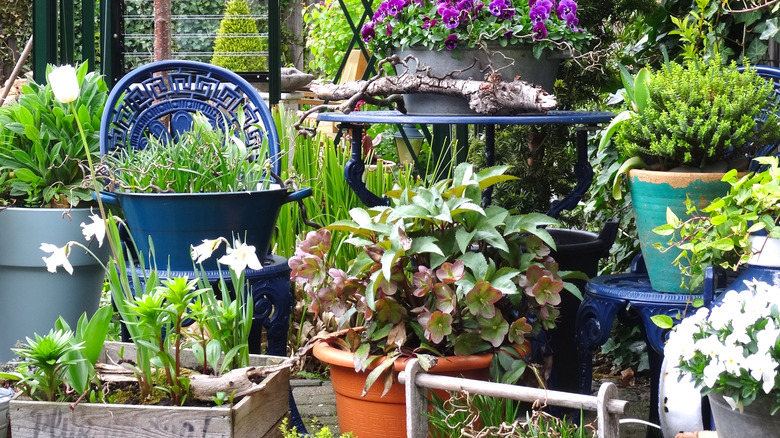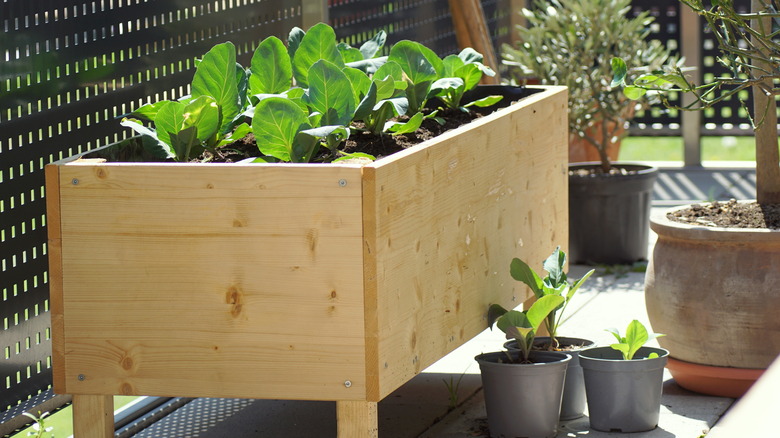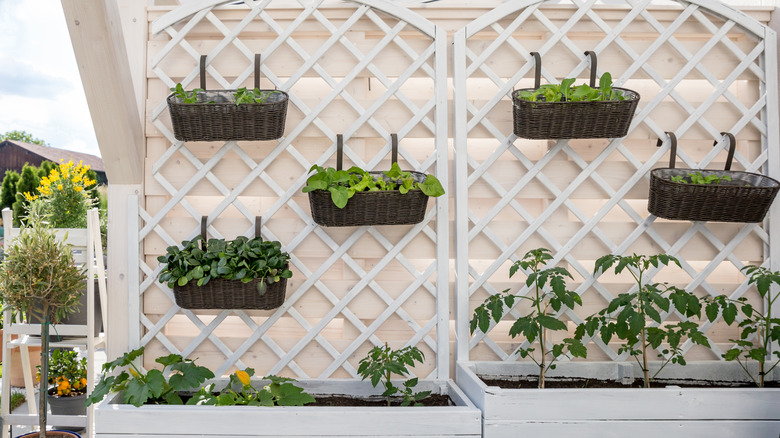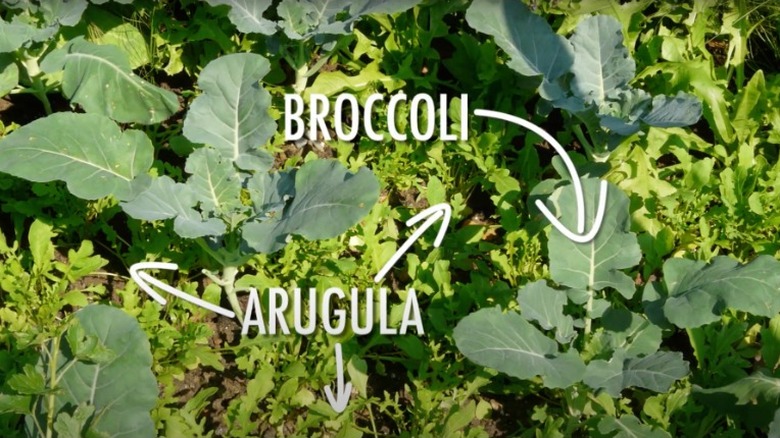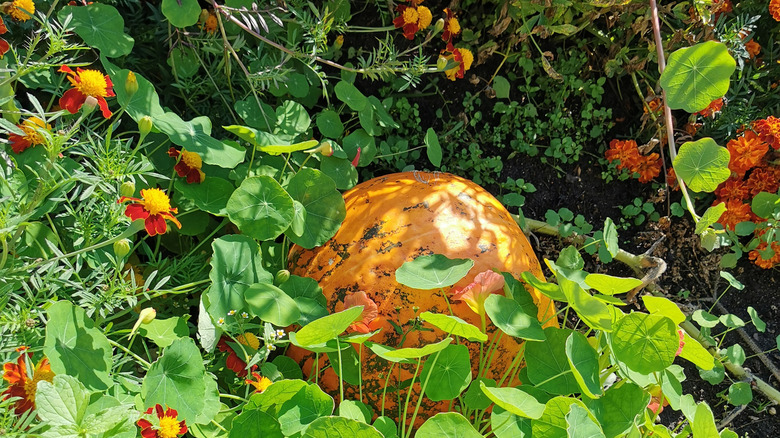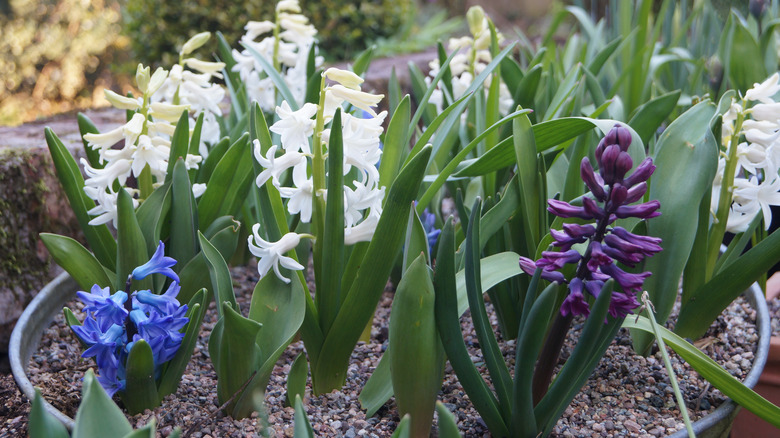How To Create A Flourishing Vegetable Garden In A Small Space
Sure, we plant addicts would love to have a flourishing garden that fills the grounds of a multi-acre estate and makes the neighbors weep with joy and a little bit of jealousy. For many of us, of course, that dream must be squeezed into a rather tight reality. Sometimes a 4-foot square patch of grass or a corner of the patio is all we can devote to our beloved garden. At first sight, it seems like we'll barely be able to grow anything, but with a little creativity and smart planning, we can create a bountiful harvest in even the smallest spaces.
Savvy gardeners have figured out how to grow their precious produce and beautiful blooms just about anywhere. Once you've identified the location of your modest garden, take a deep breath and worry not. We're here to share with you some inspired vegetable garden ideas along with key planting techniques that will help you get the most out of whatever space you have.
Utilize raised beds and containers
Got concrete? If you're standing on your back porch bemoaning your lack of an actual grass and dirt yard, you'll want to consider raised garden beds and containers right off the bat. They're conveniently mobile and hold enough soil to grow vegetables no matter what kind of surface they're standing on. Both options can be squeezed into tight spaces, and with raised beds, you can easily build one to fit a customized layout as you attempt to use every inch of a petite patio. You may even discover that you have a few vegetables growing in containers that will be perfectly happy inside your house on a windowsill. And don't forget about the front porch!
Besides helping you get around space constraints, containers and raised beds allow fewer weeds in the soil and less water runoff. You're also less likely to find yourself dealing with pests since they're elevated off the ground. From a physical standpoint, the height of a raised bed can be adjusted to accommodate less bending and kneeling, and they can be situated away from walls to let you comfortably move around on all sides for less reaching.
Get vertical
When you're short on floor space, it's time to stop focusing on the ground and look up instead. There are a number of different ways to get vertical in the garden. Trellises and fences let you train vining vegetables like cucumbers and squash up and away from the ground. Cages do something similar for tomatoes. Hanging baskets can be placed all over the place; in this way, you'll spread your garden out to find as many usable nooks and crannies as possible. Just make sure that everything is within reach of the garden hose, so you don't end up schlepping heavy watering cans.
Another thing to consider is installing shelves along an exterior wall. You can keep it simple by lining containers across them, or if you're a DIY enthusiast, have fun designing wall-mounted garden beds. Keep in mind the weight of the soil and the water, as well as the fact that everything will be getting wet on a regular basis. And don't forget to accommodate for sufficient drainage.
Maximize limited surface area with intercropping
Intercropping, also called interplanting, is a technique skilled gardeners use to maximize the use of soil surface area, and it primarily focuses on the spread and height of each plant. You'll situate different kinds of seedlings a lot closer together than would seem prudent, knowing that the smaller plants will grow faster and be harvested earlier. This will happen well before the larger, slower-growing plants must spread out and take over. With intercropping, you really need to stay on top of the progress of your plants. Keep a schedule and check on them often. Otherwise, your garden will get too crowded, and you'll end up with plants that are fighting each other for limited nutrients from the soil or blocking too much sunlight for the little guys.
The benefits of intercropping go beyond conserving space. In the example shown above, fast-growing early-season arugula is planted right up against later-season broccoli. The larger broccoli leaves shade the soil, helping to reduce weeds and retain moisture that the arugula welcomes. It's a win-win for the vegetables as well as the gardener, who can use less space to grow more.
Companion planting
When you companion plant, you purposefully group together plants that benefit each other and require the same conditions to flourish. This is particularly easy to do in a contained raised garden bed or a large pot. Companion planting has been understood and practiced for hundreds of years and is a fundamental element of Native American agriculture. Native Seeds Search explains that one of the most well-known examples of companion planting is called the Three Sisters: Corn, beans, and squash. These three work in tremendous harmony; beans convert nitrogen from the air into an absorbable nutrient for the squash and corn, the cornstalks act as trellises to usher the beans off the ground and away from the quickly spreading squash, and the squash leaves shade the soil, again reducing weeds and retaining moisture.
Companion planting further benefits your garden by improving the soil's condition and conserving space. Additionally, certain flowers naturally repel pests from specific vegetables. Nasturtiums are trusted to ward off squash bugs, making them the perfect neighbor for your pumpkins. Similarly, marigolds help prevent thrips from invading tomatoes. At the same time, flowers will beautify the garden and invite pollinators who will improve conditions even more.
Plant in succession
Succession planting is a fantastic technique for flower growers because it allows you to create a garden that never stops blooming. By mixing together plants that blossom at different times of the season, you end up with a new batch of flowers ready to burst forth, just as the ones before them are fading away. Think of late winter crocuses giving way to daffodils and tulips, which are then followed by peonies and poppies. For succession bulb planting, use the lasagna layering method to create three layers. Late bloomers get planted first and deepest. Cover them with 2 to 3 inches of soil, then plant mid-season bloomers. Add another layer of soil and finish with the early bloomers closest to the surface. Stagger the bulbs a bit rather than planting them directly on top of each other so their roots can spread out as they grow.
When it comes to small vegetable gardens, the technique can be used the same way; only you'll plan according to how long it takes for each type of vegetable to reach maturity. Succession planting can also be altered a bit if you have a vegetable you particularly like to eat, especially those that are ready to harvest early in the season. An example would be kale which can be replanted in the same spot every two weeks throughout spring. For the best success, always have seedlings ready to replace the vegetables you've just harvested.
